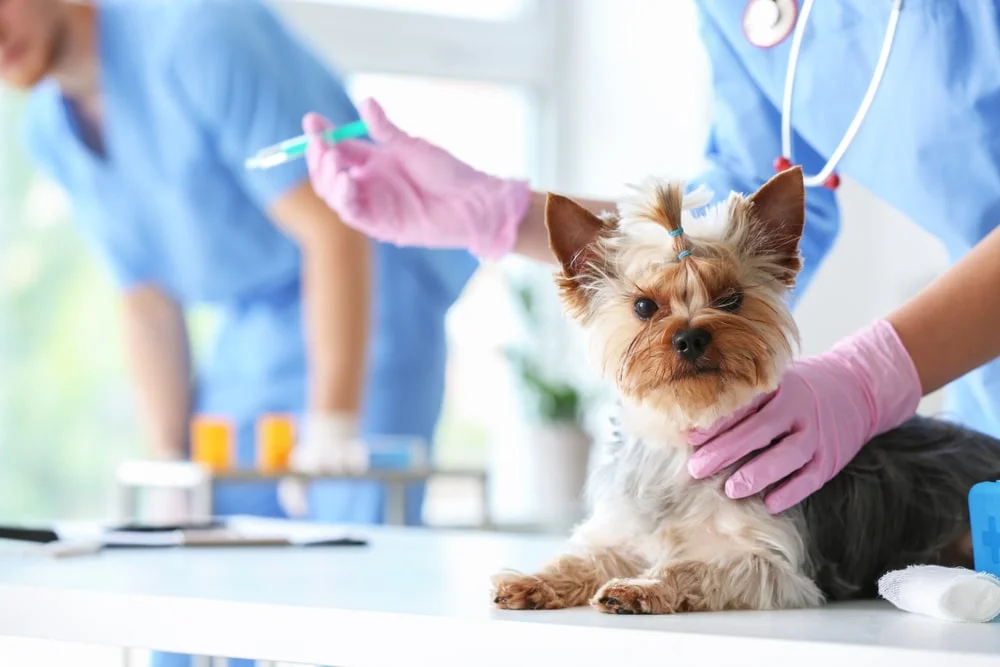PET HEALTH
Did your furry friend get poked with something it shouldn't have? Keep reading to learn what steps you should take should your furry friend get injected with poisons.
Steps To Take
When stung, pets typically paw at or rub their face and can even rub their face in the ground to remove the stinger left behind. Should you see one peek through your pet’s fur (or on his nose, lip or paw), scrape it away with a credit card, popsicle stick or other stiff, flat object. Pulling the stinger with tweezers, or your fingers could cause the poison sac to rupture, allowing the toxin it contains to enter the pet’s body.
Here are three steps you should take should your pet get injected with poisons:
- Check with your veterinarian to see if you should administer 1 mg Benadryl* per pound of your dog or cat’s body weight, and then…
- Apply a cold pack (a bag of frozen peas works well) to any swelling, removing frequently to prevent frostbite.
- Should severe swelling or any breathing difficulties develop, DO NOT DELAY! Get to your Veterinarian at once.
*NOTE: Benadryl should contain diphenhydramine, no other ingredients. Do not use time-released capsules or any liquid versions containing sugar alcohols or xylitol. Before giving you pet any medication, be sure to consult with your vet directly.
Once your dog has experienced an extreme reaction to a bee sting, it’s likely your veterinarian will prescribe an epi-pen (one dose of epinephrine measured according to your pooch's weight) to have on hand. Ask your veterinarian for specific instructions as to how to inject (generally in the outer thigh), and a veterinary visit is still required following the incident. Although the medication may help initially, some dogs go into anaphylactic shock (a severe allergic reaction) when the epinephrine wears off, so it’s better to err on the side of caution and make the trip to your vet.
Types of Threats
An insect sting is a form of injected poison as the toxin is delivered underneath the pet’s skin.
Other insects (wasps), arachnids (spiders, ticks and scorpions), reptiles (snakes) and marine life (jellyfish) can also poison your pet via a stinger, pincher, fangs or tentacles, so it is imperative you observe your pet wherever wildlife exists.
Dogs and cats are natural hunters and often go in search of smaller animals as prey, but like humans, they can experience an allergic or inflammatory reaction, if not worse, when bitten or stung by a venomous creature. Most injuries occur on the face or in the mouth, since cats and dogs try to catch the flying and crawling critters.
Pets can also sit or step on a stinging insect, arachnid or venomous reptile, so check all body parts when something isn’t quite right.
An Ounce of Prevention…
Take the following steps into consideration to help keep your pets safe from injected poisons:
- Curb the insect population in your yard by bringing food inside, using pet-safe insecticides and growing plants (such as lemongrass or catnip) that deter insects.
- Prevent access or teach pets not to sniff around cool, dark, damp locations: under and around sheds, foundations, basements, and damp areas, including places where hoses are stored, near water spigots and leaky plumbing.
- Keep dogs on-leash when hiking so that you can maneuver them away from dangerous critters, and stick to frequently traveled paths that are less likely inhabited by reptiles.
- Eliminate woodpiles, garbage and even ivy from pet play areas. These are prime locations for mice, and where mice hang out…snakes line up for dinner!
- Look into a “positively reinforced” rattlesnake aversion class to see if it can lessen prey drive if your dog is eager to go on the chase.
- At the shore, watch for signs that say jellyfish are present, but always supervise your pets at the ocean and everywhere you may travel together.
When the Worst Happens
If you don’t see the incident occur, but notice swelling to a body part or licking, you may assume your pet has been bitten or stung and should administer first-aid.
Pets can also be poisoned by substances they inhale, ingest or absorb through their skin. If you notice any of the following symptoms, seek veterinary assistance at once: pain, fever or body temperature below 100°F, profuse swelling, rash, breathing difficulty, rapid or irregular pulse, vomiting, diarrhea, lethargy, muscle tremors or rigidness, paralysis (including of the lungs) or Shock.
Don’t be caught unprepared when your furry friend needs you most. Keep the scene safe, but also know what to do, and learn Pet First Aid just in case the worst happens.
Also, be sure to check out our helpful guides for inhaled poisons, and ingested poisons.
Save Money on Emergency Vet Visits With Pet Insurance
If your dog has been stung or bitten, they may show signs of poisoning. It's important to get them to a vet quickly so they can be treated before symptoms get worse. Depending on the time of day or the situation, you might need to visit the emergency vet — which could be costly. Having a MetLife Pet Insurance policy can mean saving money on those vet bills by getting money back on covered expenses. Learn more about our coverage options by getting a free quote today.

